Ad
Course 1 service oriented architecture.pdf
- 2. Service Oriented Architecture: Right on Track
- 3. Agenda • Defining SOA – SOA, Service Orientation, Connected Systems and how they relate • Benefits of SOA • M i crosoft’ s vi si on for S O A – Why Microsoft provides the best platform for building your SOA today, and in the future
- 4. Defining SOA
- 5. • SO is an architectural paradigm for building distributed systems • SO is evolutionary • SO is a means to an end • SO can and should be an incremental process • SO is easy and can be done in- house • SO is a technology or set of technologies • SO is revolutionary • SO is the end goal • SO requires business and technology overhaul • SO is complex and requires an army of consultants Reality Myth T he onl y w ay you can use S O A for everythi ng i s to renam e everythi ng to ‘ S O A ’ Roy Schulte, Gartner Cutting through the SOA Hype
- 6. • Service – An endpoint that reacts to messages • Service Orientation – An architectural paradigm that employs the following four tenets: – Boundaries are explicit – Services are autonomous – Services share schema and contract, not class – Service compatibility is determined based on policy • Service Oriented Architecture (SOA) – Any architecture the adheres to the Four Tenets of Service Orientation Services, Service Orientation and SOA
- 7. • Services interact by exchanging messages • Each message exchange traverses boundaries and may have costs • SO formalizes intentional, and explicit interaction Tenet 1 – Boundaries are Explicit
- 8. • Services expose schemas defining data structures and contracts defining available operations • Contracts and schema may be independently versioned over time Tenet 2 – Share Schema and Contract, Not Types
- 9. • Policy is the statement of communication requirements necessary for service interaction • Service capabilities and requirements are expressed in terms of a policy expression • A policy can contain multiple assertions Tenet 3 – Policy defines Service Compatibility
- 10. • A utonom y ≠ Independence • Topology of a system evolves over time • Unlike OO, services do not share behavior • Services gracefully handle failure Tenet 4 – Services Are Autonomous
- 11. Web Services and SOA Web Services EDI/B2B EAI Distributed Computing Web Site/Portal Messaging Policies Practices Standard Protocols Universal Support Low Cost Existing Assets Best Practice Approach Technology Realization Frameworks SOA
- 12. Service Orientation Big Picture • Business Process View Business Business Component Component Business Business Component Component Business Business Process Process Composite Composite Application Application Finer Grained Finer Grained Internal Internal Service Service Operations Operations Coarse Coarse Grained Web Grained Web Service Service Operations Operations Fine Grained Fine Grained Object and Object and database calls database calls
- 13. Composition Platform Composite Applications • Applications composed of multiple service building blocks – Composed, not built – Cut across functional silos Composite Application Composite Application Portal Devices Office Other Existing Systems
- 14. Benefits of SOA
- 15. Today • Business Issues – Increased Customer Focus – Outdeliver the Competition – Get the most value for your investment • Technical Issues – Integration costs – Development time – Future proof against new technologies – Heterogeneous environment – Support new devices
- 16. Shift To Service Orientation • Connections = cost • Function oriented • Build to last • Prolonged development From From To To • Connections = value • Process oriented • Build for change • Incrementally deployed • Application silos • Tightly coupled • Object oriented • Orchestrated solutions • Loosely coupled • Message oriented
- 17. SOA Business Benefits Cost • Decreased cost – Reduces TCO and increase ROI on evolving systems – Add value to core investments by leveraging existing assets – New systems can be built faster for less money because existing services can be more easily reused – Built for flexibility – Long term value of interoperability
- 18. SOA Business Benefits Productivity • Increased employee productivity – Unlock data – Built on existing skills – Consolidate Duplicate Functionality
- 19. SOA Business Benefits Partnership • Built for partnerships – Standards based – Business relationships expressed via service interactions – Integration is driven by what is needed, not what is technically possible.
- 20. SOA Business Benefits Agility • Agility - Built for change – Helps applications evolve over time and last – Abstract the backend and replace over time – Access to the business value, no matter what technology delivers it. – Focusing on core-competencies – Incremental implementation approach is supported.
- 21. Microsoft leading the way with SOA
- 22. Microsoft and SOA • Connected Systems is the moniker we use to describe the eco-system of SOA enabled applications • SOA enables integration • Web Services is the messaging fabric for SOA • .NET is the programming model for Services • Windows and server platform is the hosting platform for Services
- 23. Microsoft SOA Business Value • XML and Web Services Built in from the ground up – Servers have had XML objects since 2000 versions – .NET Framework built for web services • More productive development environment – Fewer lines of code – Larger Ecosystem – Faster time to market • Integrated Application Environment – Developer tool built for the Framework – Framework integrated into the OS – OS services optimized for the Framework • The Application Server is built-in and evolving
- 24. M i crosoft’ s SO A Strategy • Leading the charge with Web Services • Building Connected Systems • Best platform to realize service orientation – Visual Studio – ASMX, WSE – SQL – XML – Smart Client – Office, Windows Mobile – Committed to open standards, interoperability – WS-I, W3C, OASIS, HL7, AIAG, SWIFT Perceived as leaders Perceived as leaders – – even before w e started … even before w e started …
- 25. Visual Studio Team System Edition for Software Architects
- 27. Endpoints and Application Prototypes • Endpoints – WebServiceEndpoint – WebContentEndpoint – GenericEndpoint • Applications – WindowsApplication – ASP.NETWebService – ASP.NETWebApplication – OfficeApplication – ExternalWebService – ExternalDatabase – BizTalkWebService – GenericApplication
- 30. Implementing the Application • Application architects and/or developers can implement one or more of the applications on the diagram • Implementing is the process of creating the Visual Studio projects (similar to File > New) • Generates starter source code, content, and config files based on Visual Studio templates • Implementing requires the Team Edition for Software Architects or Team Suite
- 31. Create seamless, rich user experiences Connect heterogeneous systems Provide seamless and integrated security Compose and integrate business processes Provide seamless access to multiple data stores Messaging Messaging and Services and Services Workflow Workflow and Process and Process Federated Data Identity Identity and Access and Access User User Interaction Interaction Connected Systems
- 32. Architectural Architectural Guidance Guidance SQL Server SQL Server MOM MOM Visual Studio 2005 Visual Studio 2005 Active Active Directory Directory Windows Windows Communication Communication Foundation Foundation BizTalk Server BizTalk Server Office and Office and VSTO VSTO Microsoft SOA Enablement
- 34. • U ni fi es today’ s di stri buted technol ogy stacks • Composable functionality • Appropriate for use on-machine, cross machine, and cross Internet Windows Communication Foundation “The uni fi ed program m i ng m odelfor rapi dl y bui l di ng service-ori ented appl i cati ons on the W i ndow s pl atform ” • WS-* interoperability with applications running on other platforms • Interoperabi l i ty w i th today’ s di stri buted stacks • Service-oriented programming model • Supports 4 tenets of service-orientation • Maximized developer productivity Unification Unification Productive Productive Service Service- -Oriented Oriented Programming Programming Interoperability Interoperability & Integration & Integration
- 35. WS WS- -* * Protocols Protocols Service Service- - Oriented Oriented Programming Programming Interop Interop Attribute Attribute- - Based Based Programming Programming Message Message- - Oriented Oriented Programming Programming Composability Composability Extensibility Extensibility Windows Communication Windows Communication Foundation (WCF) Foundation (WCF) (formerly Indigo) (formerly Indigo) U nion ofToday’s S tacks
- 36. [ServiceContract] Class EnterpriseTradeApp { [ServiceOperation] message ExecuteTrade (); } Class TradeApp Class TradeApp { { [WebMethod] [WebMethod] message ExecuteTrade(); message ExecuteTrade(); } } WCF WCF – – Windows Communication Foundation Windows Communication Foundation
- 37. Service Model Layer Service Model Layer Messaging Layer Messaging Layer Behaviors Behaviors Channels Channels Transaction Behavior CLR Type Integration Instancing Behavior Security Channel HTTP Transport Custom Channel Reliable Messaging Queue Transport MSMQ Integration TCP Transport Named Pipes Throttling Behavior Error Handling Behavior Concurrency Behavior Metadata Behavior Custom Behavior HTTP Transport TCP Transport Security Channel Custom Channel Reliable Messaging CLR Type Integration Instancing Behavior Transaction Behavior Composability in Action
- 38. • End-to-end Security – Confidentiality, integrity, authentication, authorization – X509, Username/Password, Kerberos, SAML, custom • End-to-end Reliable messaging – In-order guarantees – Exactly once guarantees • Transactions – Guaranteed atomic success or failure across services Feature Overview Security, Reliability, Transactions
- 39. 20,379 lines security 5,988 lines reliable messaging 25,507 lines transactions Total lines 56,296 4,442 lines infrastructure class HelloService { [WebMethod] public String Hello(String Greeting) { X509CertificateCollection collection = new X509CertificateCollection(); IntPtr blob = Marshal.AllocHGlobal(Marshal.SizeOf( typeof(CRYPTOAPI_BLOB))); IntPtr data = (IntPtr)((int)blob + Marshal.SizeOf(typeof(CRYPTOAPI_BLOB))); … SeqAckRange range = new SeqAcknRange(id, low, high ); SeqAckRange[] ranges = { range }; ReliableQueue.ProcessAcks( ranges ); … hr = pITxDispenser->BeginTransaction (NULL, ISOLATIONLEVEL_SERIALIZABLE, 0, pITxOptions, &pITransaction); … return Greeting; } } Development Productivity Using Visual Studio .NET 2003
- 40. Development Productivity Using Visual Studio .NET 2003 and WSE 10 lines security 1,804 lines reliable messaging 25,507 lines transactions Total lines 27,321 class HelloService { [WebMethod] public String Hello(String Greeting) { foreach ( SecurityToken tok in requestContext.Security.Tokens { X509SecurityToken token = tok as X509SecToken } … SeqAckRange range = new SeqAcknRange(id,low,high ); SeqAckRange[] ranges = { range }; ReliableQueue.ProcessAcks( ranges ); … hr = pITxDispenser->BeginTransaction (NULL, ISOLATIONLEVEL_SERIALIZABLE, 0, pITxOptions, &pITransaction); … return Greeting; } }
- 41. Development Productivity Using Visual Studio 2005 and WCF (Indigo) 1 lines security 1 lines reliable messaging 1 lines transactions Total lines 3 [ServiceContract(SecureChannel, SecurityMode =“Windows")] [Reliability(Guarantees.ExactlyOnce | Guarantees.InOrder)] [ServiceContract] class HelloService { [ServiceOperation(TransactionFlowAllowed = true)] String Hello(String Greeting) { return Greeting; }
- 42. Contract Policy (WS Contract Policy (WS- -Policy) Policy) • • Requires WS Requires WS- -Security, Trust, SCT Security, Trust, SCT • • Requires use of TCP SOAP binding Requires use of TCP SOAP binding Class MyService Class MyService { { } } int MyMethod(string arg) int MyMethod(string arg) { { } } Application Code Application Code What is Exposed What is Exposed Nothing! Nothing! Boundaries are explicit Boundaries are explicit [TcpTransport] [TcpTransport] [ServiceOperation] [ServiceOperation] [FederatedSecurity] [FederatedSecurity] [Discoverable] [Discoverable] Autonomy (WS Autonomy (WS- -Security family, WS Security family, WS- -Discovery) Discovery) • • Assume any messages received are rogue Assume any messages received are rogue • • A utom atically announces the service’s existence on A utom atically announces the service’s existence on startup, optionally to central directory startup, optionally to central directory • • Exposes endpoint that responds to Find requests Exposes endpoint that responds to Find requests Nothing about implementation/platform exposed. Nothing about implementation/platform exposed. Find and call the service using public standards with any Find and call the service using public standards with any implementation. implementation. [ServiceContract] [ServiceContract] Contract Schema (WSDL + XSD) Contract Schema (WSDL + XSD) • • Requires message body <arg> Requires message body <arg> string < string <arg> arg> • • Service reply message body <return> Service reply message body <return> int < int <return> return> How WCF implements the How WCF implements the tenets of SOA tenets of SOA
- 43. Roadmap Provides Continuity • WCF will supersede existing connected systems technologies. • Other technologies continue to co-exist, interoperate and be supported via support policy WCF ASMX Enterprise Services .NET Remoting Com(+) MSMQ ASMX WSE1 WSE2 WSE-n
- 44. Designing for WCF • Build services using ASMX • Use WSE for WS-* support • Keep components within your service boundaries • Use System.Messaging for async queued messaging • Use Enterprise Services when transactions, activation required • Avoid or abstract low-level .NET Remoting extensibility such as sinks, channels
- 45. • Service Orientation is an architectural paradigm, conforming to the four tenets • Service Orientation reflects the realities of building heterogeneous distributed systems • Service Orientation enables agility and the ability to leverage existing assets, without having to rip-and-replace • The Microsoft platform provides the best tools to enable you to build Service Oriented systems today and leads the industry in innovation for the future Summary
- 46. CALL TO ACTION • Learn about SOA – Ask questions – http://blogs.msdn.com/pooyad • Use Visual Studio 2005 – create web services (i f you haven’ t al ready, and see how easy it is) – http://msdn.microsoft.com/vstudio/ • Visual Studio 2005 Express (CD in your bags) • K eep up to date w i th M i crosoft’ s A rchi tecture Vision – http://www.architecturejournal.net/ • Sign up for the Architecture Journal














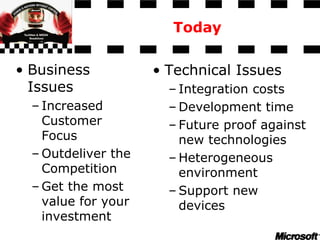

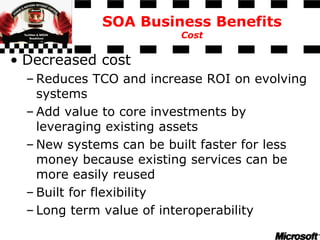

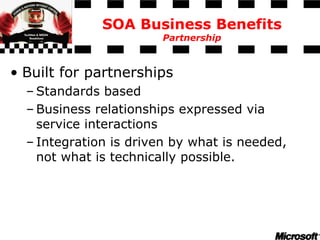

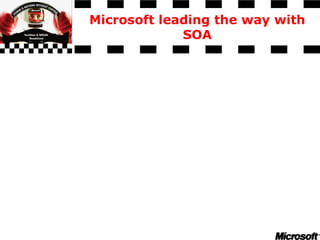





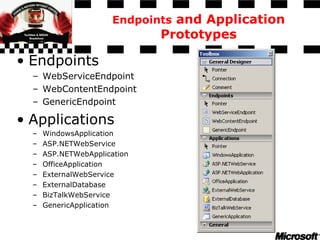

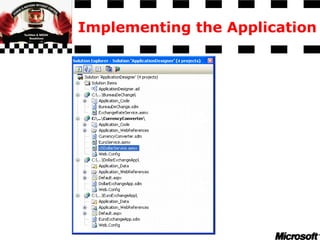






![[ServiceContract]
Class EnterpriseTradeApp {
[ServiceOperation]
message ExecuteTrade ();
}
Class TradeApp
Class TradeApp
{
{
[WebMethod]
[WebMethod]
message ExecuteTrade();
message ExecuteTrade();
}
}
WCF
WCF –
– Windows Communication Foundation
Windows Communication Foundation](https://image.slidesharecdn.com/serviceorientedarchitecture-240913164705-75211e9f/85/Course-1-service-oriented-architecture-pdf-36-320.jpg)


![20,379 lines
security
5,988 lines
reliable messaging
25,507 lines
transactions
Total lines
56,296
4,442 lines
infrastructure
class HelloService {
[WebMethod]
public String Hello(String Greeting) {
X509CertificateCollection collection = new
X509CertificateCollection();
IntPtr blob = Marshal.AllocHGlobal(Marshal.SizeOf(
typeof(CRYPTOAPI_BLOB)));
IntPtr data = (IntPtr)((int)blob +
Marshal.SizeOf(typeof(CRYPTOAPI_BLOB)));
…
SeqAckRange range = new SeqAcknRange(id, low, high );
SeqAckRange[] ranges = { range };
ReliableQueue.ProcessAcks( ranges );
…
hr = pITxDispenser->BeginTransaction (NULL,
ISOLATIONLEVEL_SERIALIZABLE, 0, pITxOptions,
&pITransaction);
…
return Greeting;
}
}
Development Productivity
Using Visual Studio .NET 2003](https://image.slidesharecdn.com/serviceorientedarchitecture-240913164705-75211e9f/85/Course-1-service-oriented-architecture-pdf-39-320.jpg)
![Development Productivity
Using Visual Studio .NET 2003 and WSE
10 lines
security
1,804 lines
reliable messaging
25,507 lines
transactions
Total lines
27,321
class HelloService {
[WebMethod]
public String Hello(String Greeting) {
foreach ( SecurityToken tok in
requestContext.Security.Tokens
{
X509SecurityToken token = tok as X509SecToken
}
…
SeqAckRange range = new SeqAcknRange(id,low,high );
SeqAckRange[] ranges = { range };
ReliableQueue.ProcessAcks( ranges );
…
hr = pITxDispenser->BeginTransaction (NULL,
ISOLATIONLEVEL_SERIALIZABLE, 0, pITxOptions,
&pITransaction);
…
return Greeting;
}
}](https://image.slidesharecdn.com/serviceorientedarchitecture-240913164705-75211e9f/85/Course-1-service-oriented-architecture-pdf-40-320.jpg)
![Development Productivity
Using Visual Studio 2005 and WCF (Indigo)
1 lines
security
1 lines
reliable messaging
1 lines
transactions
Total lines 3
[ServiceContract(SecureChannel, SecurityMode =“Windows")]
[Reliability(Guarantees.ExactlyOnce | Guarantees.InOrder)]
[ServiceContract]
class HelloService
{
[ServiceOperation(TransactionFlowAllowed = true)]
String Hello(String Greeting)
{
return Greeting;
}](https://image.slidesharecdn.com/serviceorientedarchitecture-240913164705-75211e9f/85/Course-1-service-oriented-architecture-pdf-41-320.jpg)
![Contract Policy (WS
Contract Policy (WS-
-Policy)
Policy)
•
• Requires WS
Requires WS-
-Security, Trust, SCT
Security, Trust, SCT
•
• Requires use of TCP SOAP binding
Requires use of TCP SOAP binding
Class MyService
Class MyService
{
{
}
}
int MyMethod(string arg)
int MyMethod(string arg)
{
{
}
}
Application Code
Application Code What is Exposed
What is Exposed
Nothing!
Nothing!
Boundaries are explicit
Boundaries are explicit
[TcpTransport]
[TcpTransport]
[ServiceOperation]
[ServiceOperation]
[FederatedSecurity]
[FederatedSecurity]
[Discoverable]
[Discoverable]
Autonomy (WS
Autonomy (WS-
-Security family, WS
Security family, WS-
-Discovery)
Discovery)
•
• Assume any messages received are rogue
Assume any messages received are rogue
•
• A utom atically announces the service’s existence on
A utom atically announces the service’s existence on
startup, optionally to central directory
startup, optionally to central directory
•
• Exposes endpoint that responds to Find requests
Exposes endpoint that responds to Find requests
Nothing about implementation/platform exposed.
Nothing about implementation/platform exposed.
Find and call the service using public standards with any
Find and call the service using public standards with any
implementation.
implementation.
[ServiceContract]
[ServiceContract]
Contract Schema (WSDL + XSD)
Contract Schema (WSDL + XSD)
•
• Requires message body <arg>
Requires message body <arg> string <
string <arg>
arg>
•
• Service reply message body <return>
Service reply message body <return> int <
int <return>
return>
How WCF implements the
How WCF implements the
tenets of SOA
tenets of SOA](https://image.slidesharecdn.com/serviceorientedarchitecture-240913164705-75211e9f/85/Course-1-service-oriented-architecture-pdf-42-320.jpg)



















































